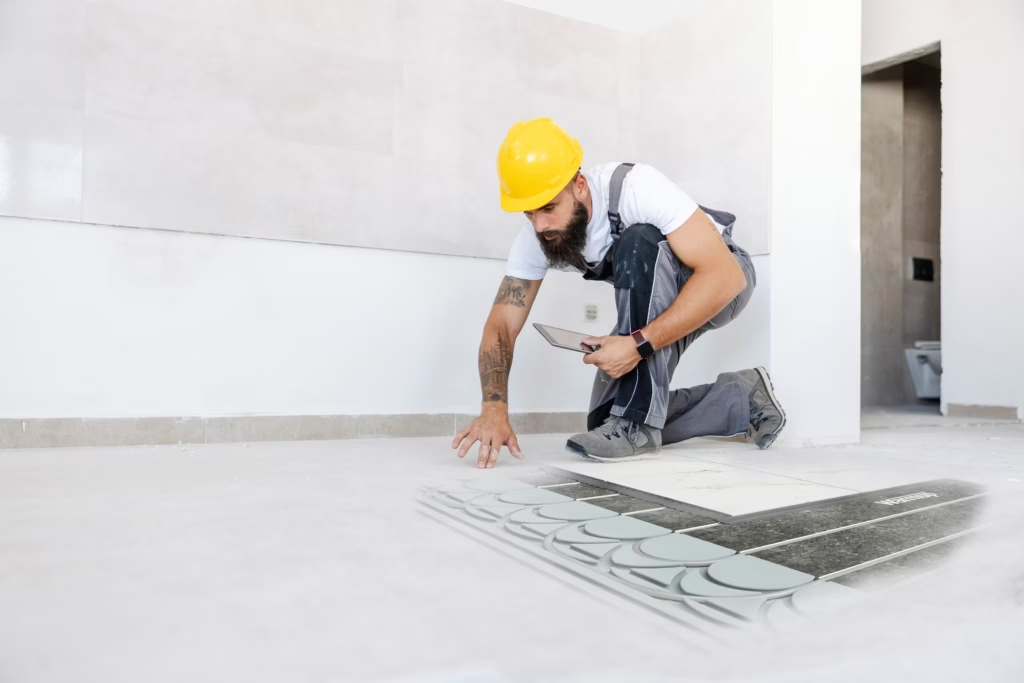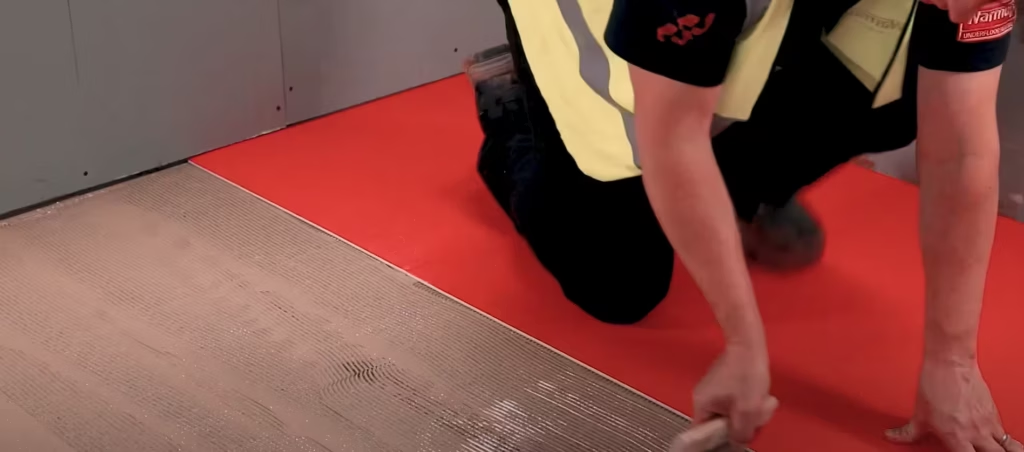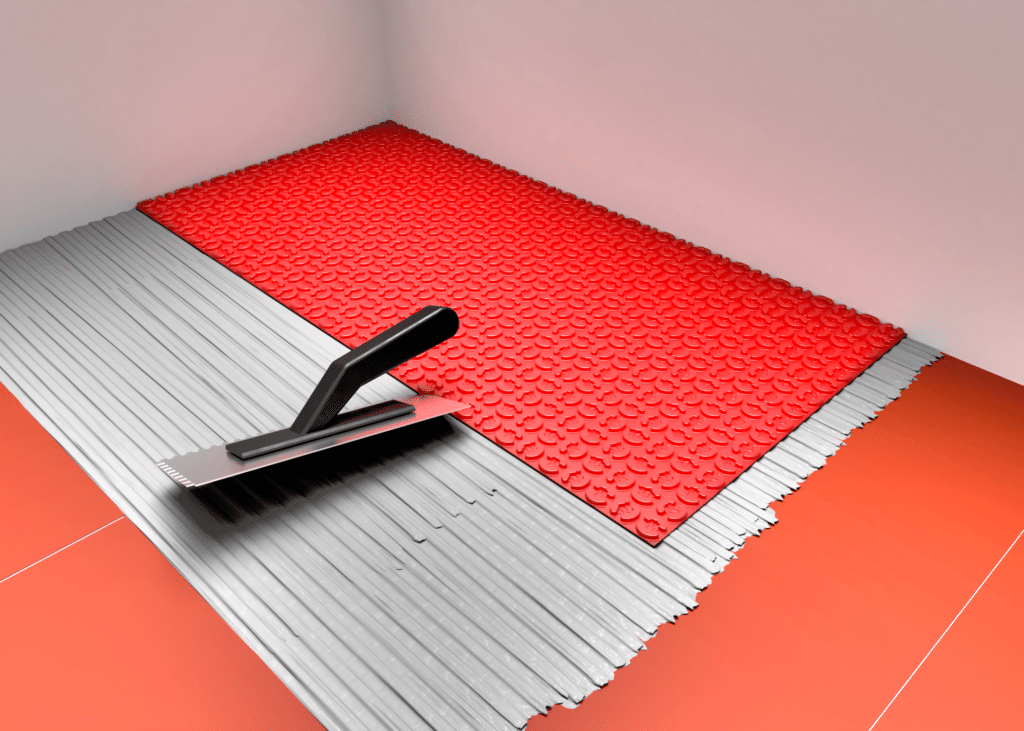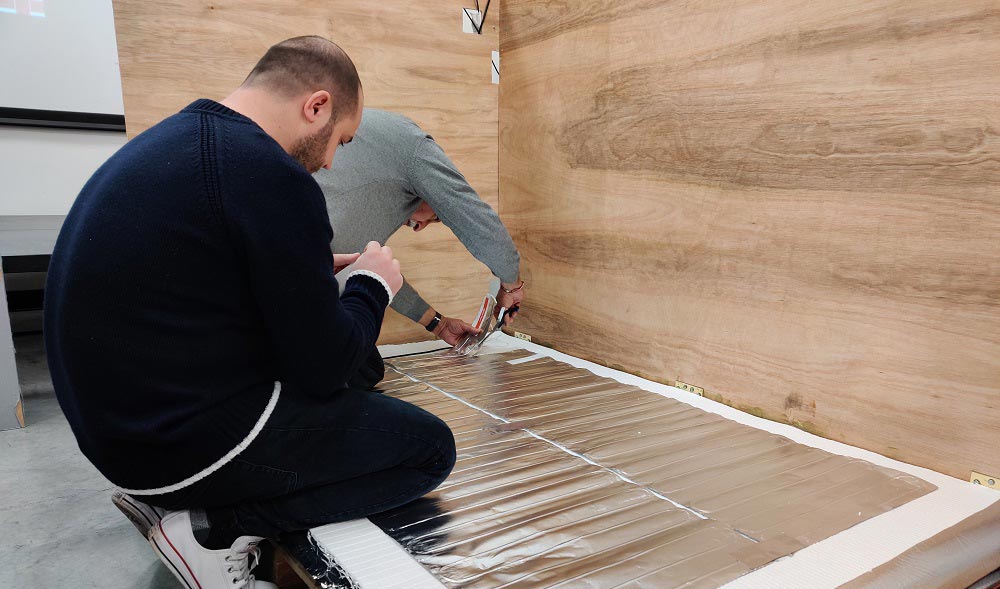Installing a new floor heating system is simpler than you may think and there are some tricks of the trade that will help make your installation a truly hassle-free experience. In this guide, we’ll explore the best adhesive options to use with your new water or electric system when fitted with a range of subfloors and floor coverings, you’ll discover:
- Why good-quality adhesives are so important for installing floor heating
- Understanding the differences between adhesive options
- How to prepare your subfloor
- The best adhesives to use with underfloor heating
- The benefits of Warmup’s Stick&Go UFH Glue for your project
How do I select the right adhesive to use with a floor heating system?
As part of the installation process, many underfloor heating systems require a layer of adhesive either installed above or below the system: some systems will require you to use adhesive to bond the system to the subfloor or accompanying insulation material while others may require using adhesives to fit the floor finish over the system.
Using a good-quality adhesive is important because you’ll want to make sure it can withstand the temperature changes of your flooring that the UFH system will produce. The best adhesives will have undertaken rigorous testing that conform to the European Standard for you to feel confident with your choice. These tests will quantify the level of polymer in an adhesive – the higher the level of polymer, the better the adhesive will perform in areas of temperature change. The adhesive’s bond strength will be tested at 70ºC, which is fundamental for an adhesive used with floor heating and bond strength is usually tested in dry conditions, under water (known as wet storage) and freeze/thaw conditions. Adhesives that do not perform well under European Standard tests have a stronger likelihood of failing when used with underfloor heating.
What do the codes used for adhesives mean?
When searching for suitable adhesives, you may come across descriptions on the packaging or websites that may look like coded language. These codes usually consist of a series of numbers and letters which refer to the adhesive’s performance in the tests mentioned above. Let’s take a look at these codes and examine what they mean.
| Code | Code Meaning | Description of Classification |
| F | Fast Setting | An adhesive which has been modified to set rapidly. This enables tiling and grouting to be carried out in a shorter time frame. |
| T | Reduced Slip | ‘Slip’ refers to the vertical movement of a tile after it has been bedded into an adhesive. Traditionally, battens have been used to prevent slump, but modern adhesives are modified with reduced slip properties. |
| E | Extended Open Time | The time, usually in minutes, after application of an adhesive within which it will still bond and secure the tile. |
| C2 | Improved Cementitious Adhesive | An improved cementitious adhesive has a higher bond strength, which means it fixes tiles to difficult substrates easily. This classification is particularly important when using porcelain tiles. |
| S1 | Deformable Adhesive | This classification refers to an adhesive’s ability to withstand small movements, such as the expanding and contracting of floors where UFH has been installed. |
| S2 | Highly Deformable Adhesive | A highly deformable adhesive means it can withstand even more movement than an S1 classification adhesive – particularly important for UFH. |
For the most part, Warmup recommends using either ‘S1′ or ‘S2’ adhesives with our range of floor heating systems. The deformability, durability, and capability of withstanding high and frequent temperature changes of both S1 and S2 adhesives make them perfect to use. S1 adhesives are ideal to adhere an UFH system onto solid subfloors such as screed and timber. Whereas an S2 adhesive should be used with compressible surfaces, such as over floor insulation which will enhance the efficiency of the system. S2 adhesives are also typically recommended to bond the final floor covering to the system itself.

How do I prepare my subfloor for UFH installation?
Whether you’re installing an electric or water UFH system, it’s important to prepare your subfloor correctly to ensure that your new heating solution performs at its best. The starting point to a project is choosing the right materials that suit the project specifications: the better the material, the more reliable the results. You should always make sure that you follow the recommended guidelines when mixing your chosen adhesives and when installing an underfloor heating system. Every heating system is installed in a different way, so it is essential to follow the installation manual.
Before installing any floor heating system, you should clean your subfloors of any debris and dust and make sure that it is level. If you’re installing a heating system directly onto a plywood or concrete subfloor, Warmup Primer should be used. Depending on your project’s requirements, primer may also be required when installing underfloor heating with floor insulation. You can purchase insulation boards to use with our range of electric heaters separately while most of our water systems come with accompanying insulation materials or feature in-built insulation. Our Ultralight UFH Boards should be installed onto the subfloor using a flexible adhesive before fitting your selected heating system above.
Which type of adhesive should I use with my electric UFH system?
Electric underfloor heating systems come in the form of either electric heating cables or heating mats, some of which may require the usage of an adhesive to adhere the system to the subfloor or insulation paneling and some requiring tile adhesive to adhere the flooring to the system itself. Because these systems sit only a few millimeters above the sub-floor and are very close to the floor finish, it is advised to:
– Use an adhesive with more flexibility than standard adhesives to cope with seasonal sub-floor movements
– Use an adhesive containing high polymer levels in order to deal with frequent temperature changes coming from the UFH system.
The DCM-PRO Heated Decoupling System is a popular heating cable system for use with tiled floors and is available with two membrane options: Peel and Stick or fleece-backed. The Peel and Stick membrane utilises a self-adhesive backing whilst the fleeced-backed membrane allows for the use of adhesives to adhere it to the subfloor. If you’re interested in installing a fleece-backed DCM-PRO over our Ultralight Underfloor Heating Boards, you should use an S2 adhesive for a successful installation. An S2 tile adhesive should also be used on top of DCM-PRO to affix your chosen floor tiles. Likewise, the StickyMat System also features a self-adhesive backing and should also be used with a S2 adhesive when fitting it with tiled floor finishes. If you’re using other floor finishes with the DCM-PRO and StickyMat systems, you can also use 10 mm of levelling compound to cover the system in lieu of tile adhesive. The levelling compound you select must be compatible with electric underfloor heating and must be applied as a single layer. You can find more top tips about installing electric underfloor heating in our informative article.

Do I need an adhesive for my water floor heating system?
Water underfloor heating systems can be split into those systems which are installed within the subfloor and those fitted above the subfloor in the form of a panel-based system. Some of these panel-based systems will require usage of an adhesive to fix the system to the subfloor whilst all will require tile adhesive when fitting with floor tiling. For the most part, the majority of flexible tile adhesives that are compatible with electric floor heating systems, are also compatible with water systems. You should ensure that:
– The adhesive needs to contain high levels of polymer to cope with frequent temperature changes.
– The adhesive needs to be flexible in order to cope with movement in the sub-floor without damaging your chosen floor surface.
What is the best underfloor heating adhesive?
Warmup’s Stick&Go UFH Glue offers a superior alternative to traditional tile adhesives and has been specifically designed for use with the Ultralight UFH Boards and the VLo Ultra-12 Low Build water floor heating system to adhere these products securely to the subfloor.
Unlike other adhesives, which require on-site mixing and significant curing times, Stick&Go can be used straight from the tub and will perform well on cold, damp and dirty substrates. Its unique formulation means that it remains effective in temperatures of just above freezing, supporting year-round floor heating installations. Stick&Go UFH Glue should be applied in an ultra-thin layer, typically just 1mm, ensuring minimal impact on finished floor heights and with 10m² coverage per 16kg tub and a 1-year lifespan, it can be used for multiple projects.
Interested in using Stick&Go in your upcoming project? Find out everything you need to know in our in-depth guide.




![Thumbnail [200x250]](/wp-content/uploads/Electric-Category-Page-Image.jpg)
![Thumbnail [200x250]](/wp-content/uploads/Hydronic-Category-Page-Image-1.jpg)
![Thumbnail [200x250]](/wp-content/uploads/6iE-Projects.jpg)